主谓一致学案
高考英语总复习主谓一致专题学案
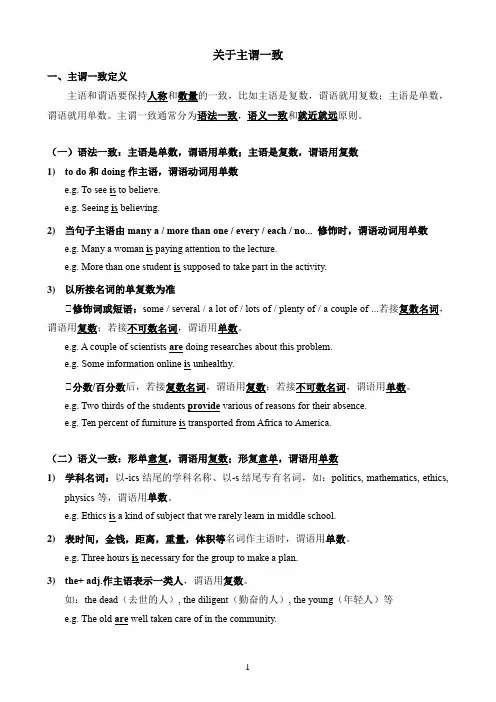
关于主谓一致一、主谓一致定义主语和谓语要保持人称和数量的一致,比如主语是复数,谓语就用复数;主语是单数,谓语就用单数。
主谓一致通常分为语法一致,语义一致和就近就远原则。
(一)语法一致:主语是单数,谓语用单数;主语是复数,谓语用复数1)to do和doing作主语,谓语动词用单数e.g. To see is to believe.e.g. Seeing is believing.2)当句子主语由many a / more than one / every / each / no... 修饰时,谓语动词用单数e.g. Many a woman is paying attention to the lecture.e.g. More than one student is supposed to take part in the activity.3)以所接名词的单复数为准①修饰词或短语:some / several / a lot of / lots of / plenty of / a couple of ...若接复数名词,谓语用复数;若接不可数名词,谓语用单数。
e.g. A couple of scientists are doing researches about this problem.e.g. Some information online is unhealthy.①分数/百分数后,若接复数名词,谓语用复数;若接不可数名词,谓语用单数。
e.g. Two thirds of the students provide various of reasons for their absence.e.g. Ten percent of furniture is transported from Africa to America.(二)语义一致:形单意复,谓语用复数;形复意单,谓语用单数1)学科名词:以-ics结尾的学科名称、以-s结尾专有名词,如:politics, mathematics, ethics,physics等,谓语用单数。
大学主谓一致教案
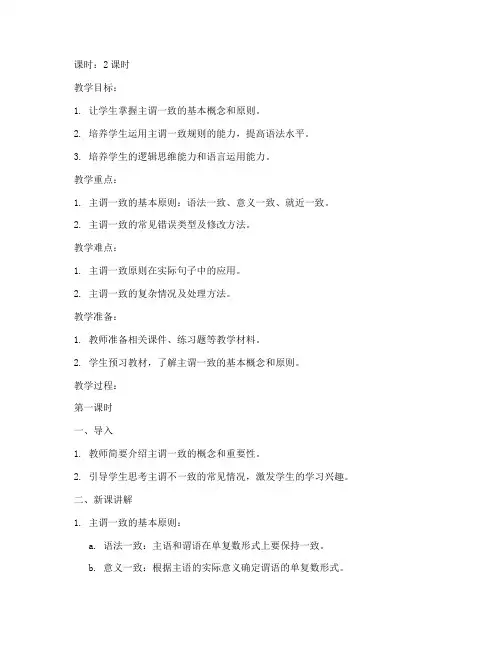
课时:2课时教学目标:1. 让学生掌握主谓一致的基本概念和原则。
2. 培养学生运用主谓一致规则的能力,提高语法水平。
3. 培养学生的逻辑思维能力和语言运用能力。
教学重点:1. 主谓一致的基本原则:语法一致、意义一致、就近一致。
2. 主谓一致的常见错误类型及修改方法。
教学难点:1. 主谓一致原则在实际句子中的应用。
2. 主谓一致的复杂情况及处理方法。
教学准备:1. 教师准备相关课件、练习题等教学材料。
2. 学生预习教材,了解主谓一致的基本概念和原则。
教学过程:第一课时一、导入1. 教师简要介绍主谓一致的概念和重要性。
2. 引导学生思考主谓不一致的常见情况,激发学生的学习兴趣。
二、新课讲解1. 主谓一致的基本原则:a. 语法一致:主语和谓语在单复数形式上要保持一致。
b. 意义一致:根据主语的实际意义确定谓语的单复数形式。
c. 就近一致:当主语由多个词构成时,谓语动词的形式取决于最靠近它的主语。
2. 主谓一致的应用:a. 集体名词作主语时,根据集体名词的实际意义确定谓语的单复数形式。
b. 名词作主语时,根据名词的复数形式确定谓语的单复数形式。
c. 不定代词、数词、量词等作主语时,根据其意义确定谓语的单复数形式。
三、课堂练习1. 教师出示练习题,学生独立完成。
2. 教师讲解练习题,分析错误原因,纠正学生错误。
四、总结1. 教师总结本节课所学内容,强调主谓一致的重要性。
2. 布置课后作业,巩固所学知识。
第二课时一、复习导入1. 教师提问上节课所学内容,检查学生对主谓一致原则的掌握情况。
2. 引导学生回忆主谓不一致的常见错误类型。
二、新课讲解1. 主谓不一致的常见错误类型及修改方法:a. 误用单复数:根据主语的实际意义确定谓语的单复数形式。
b. 误用主谓一致原则:根据主谓一致的基本原则进行修改。
c. 误用就近一致原则:根据就近一致原则进行修改。
2. 复杂情况及处理方法:a. 名词作主语时,根据名词的复数形式确定谓语的单复数形式。
主谓一致教案市公开课一等奖教案省赛课金奖教案
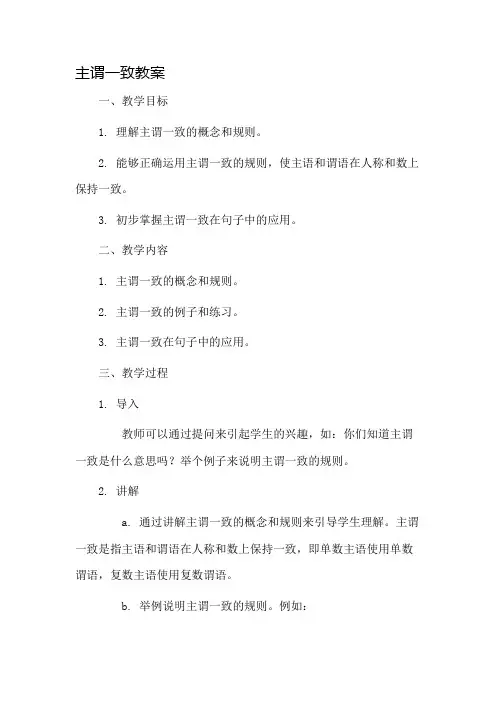
主谓一致教案一、教学目标1. 理解主谓一致的概念和规则。
2. 能够正确运用主谓一致的规则,使主语和谓语在人称和数上保持一致。
3. 初步掌握主谓一致在句子中的应用。
二、教学内容1. 主谓一致的概念和规则。
2. 主谓一致的例子和练习。
3. 主谓一致在句子中的应用。
三、教学过程1. 导入教师可以通过提问来引起学生的兴趣,如:你们知道主谓一致是什么意思吗?举个例子来说明主谓一致的规则。
2. 讲解a. 通过讲解主谓一致的概念和规则来引导学生理解。
主谓一致是指主语和谓语在人称和数上保持一致,即单数主语使用单数谓语,复数主语使用复数谓语。
b. 举例说明主谓一致的规则。
例如:- Singular subject + singular verb: She goes to school every day.- Plural subject + plural verb: They play basketball on weekends.3. 练习a. 让学生自己思考并完成一些主谓一致的练习题,如填空题、改错题等。
b. 教师可以提供一些例子,让学生判断主谓是否一致,并给出答案和解释。
例如:The dog barks / bark every night.(barks)4. 拓展应用a. 让学生通过完成一些综合句子的写作来应用主谓一致的规则。
b. 学生可以与同学一起合作讨论,互相纠错和改进。
5. 总结和小结教师对本节课的内容进行总结,并强调主谓一致的重要性和正确运用的方法。
四、课堂练习1. 单项选择1. After school, he usually ____ a bike.A. ridesB. rideC. ridingD. to ride2. My parents _____ in the garden every weekend.A. worksB. workC. workingD. to work2. 改错题阅读下列句子,判断是否存在主谓一致错误,如果有错误,请改正之。
主谓一致教案
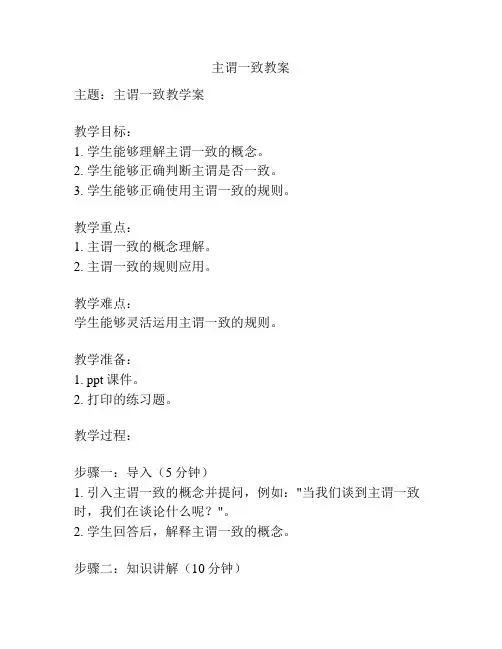
主谓一致教案主题:主谓一致教学案教学目标:1. 学生能够理解主谓一致的概念。
2. 学生能够正确判断主谓是否一致。
3. 学生能够正确使用主谓一致的规则。
教学重点:1. 主谓一致的概念理解。
2. 主谓一致的规则应用。
教学难点:学生能够灵活运用主谓一致的规则。
教学准备:1. ppt课件。
2. 打印的练习题。
教学过程:步骤一:导入(5分钟)1. 引入主谓一致的概念并提问,例如:"当我们谈到主谓一致时,我们在谈论什么呢?"。
2. 学生回答后,解释主谓一致的概念。
步骤二:知识讲解(10分钟)1. 利用ppt课件讲解主谓一致的规则和例子,例如:"当主语是单数时,谓语动词也要是单数形式"。
2. 强调需要注意的例外情况,例如:"当主语是复数且表达一体的团体时,谓语动词可以用单数形式"。
步骤三:示范与练习(15分钟)1. 在黑板上写出几个句子,让学生判断主谓是否一致,然后解释他们的判断。
2. 分发练习题,让学生在课堂上完成,然后相互交换纠正。
步骤四:总结与评价(5分钟)1. 回顾主谓一致的规则,并强调需要注意的地方。
2. 鼓励学生在实际写作和口语表达中注意主谓一致的错误。
步骤五:作业布置(5分钟)1. 布置练习题作为课后作业,要求学生完成剩下的题目。
2. 课堂上遗留的问题可以让学生在家里复习后提问或直接向老师请教。
教学评价:1. 学生能够准确理解和解释主谓一致的概念。
2. 学生能够正确判断主谓是否一致。
3. 学生能够正确运用主谓一致的规则。
4. 学生能够在写作和口语表达中避免主谓一致的错误。
(完整word版)主谓一致导学案
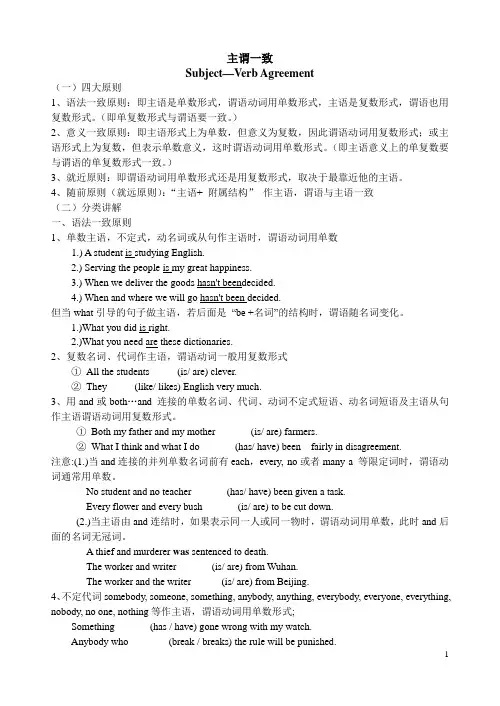
主谓一致Subject—Verb Agreement(一)四大原则1、语法一致原则:即主语是单数形式,谓语动词用单数形式,主语是复数形式,谓语也用复数形式。
(即单复数形式与谓语要一致。
)2、意义一致原则:即主语形式上为单数,但意义为复数,因此谓语动词用复数形式;或主语形式上为复数,但表示单数意义,这时谓语动词用单数形式。
(即主语意义上的单复数要与谓语的单复数形式一致。
)3、就近原则:即谓语动词用单数形式还是用复数形式,取决于最靠近他的主语。
4、随前原则(就远原则):“主语+ 附属结构”作主语,谓语与主语一致(二)分类讲解一、语法一致原则1、单数主语,不定式,动名词或从句作主语时,谓语动词用单数1.) A student is studying English.2.) Serving the people is my great happiness.3.) When we deliver the goods hasn't beendecided.4.) When and where we will go hasn't been decided.但当what引导的句子做主语,若后面是“be +名词”的结构时,谓语随名词变化。
1.)What you did is right.2.)What you need are these dictionaries.2、复数名词、代词作主语,谓语动词一般用复数形式①All the students _____(is/ are) clever.②They _____(like/ likes) English very much.3、用and或both…and 连接的单数名词、代词、动词不定式短语、动名词短语及主语从句作主语谓语动词用复数形式。
①Both my father and my mother ______ (is/ are) farmers.②What I think and what I do ______ (has/ have) been fairly in disagreement.注意:(1.)当and连接的并列单数名词前有each,every, no或者many a 等限定词时,谓语动词通常用单数。
主谓一致复习导学案

主谓一致复习导学案导语:主谓一致是英语语法中非常基础且重要的概念,它指的是主语和谓语在人称和数上的一致。
正确理解和掌握主谓一致的规则,对于正确表达思想和交流意义至关重要。
本文将为大家介绍主谓一致的基本规则,并提供一些练习来帮助大家巩固知识。
一、主谓一致的基本规则在一句英语句子中,主语和谓语必须在人称和数上保持一致。
具体来说,有以下几条规则需要遵循:1. 单数主语与单数谓语一致:例如:He runs every morning.(他每天早上跑步。
)2. 复数主语与复数谓语一致:例如:They play soccer on weekends.(他们周末踢足球。
)3. 若主语以“each, every, either, neither, anyone, everyone, nobody, somebody, something”等表示“每一个”、“任何一个”之意的词开头,谓语动词用单数形式。
例如:Each student has to submit a report.(每个学生都要提交一份报告。
)4. 若两个或两个以上的名词作主语,用 and 连接时,谓语动词用复数形式。
例如:John and Mary are good friends.(约翰和玛丽是好朋友。
)5. 若两个或两个以上的名词作主语,用 or,either...or,neither...nor等连词连接时,谓语动词与最靠近的名词在数上保持一致。
例如:Neither John nor his friends are here.(约翰和他的朋友们都不在这里。
)二、练习题为了帮助大家更好地理解和掌握主谓一致的规则,请完成以下练习题。
根据句意和语法规则,填写正确的动词形式。
1. Neither the students nor the teacher ________ (know) the answer to the question.2. Every student in our class ________ (have) a computer.3. The dog and the cat ________ (play) in the garden.4. Each of them ________ (carry) a heavy bag.5. Either my parents or my brother ________ (go) to the concert with me.6. Nobody ________ (want) to go to the party.7. One of the apples ________ (is) rotten.参考答案:1. knows2. has3. play4. carries5. goes6. wants7. is三、总结主谓一致是英语语法中的基础知识,正确的使用可以使句子更加准确和清晰。
主谓一致学案
主谓一致(一)语法一致原则:语法上一致就是谓语动词和主语在单、复数形式上保持一致。
1、以单数名词或代词、动词不定式短语、动名词短语或从句作主语时,谓语动词一般用单数形式;主语为复数时,谓语动词用复数形式。
His father is working on the farm. / To study English well is not easy. / What he said is very important for us all. / The children were in the classroom two hours ago. / Reading in the sun is bad for your eyes.注意:由what引导的主语从句,后面的谓语动词多数情况用单数形式,但若表语是复数或what从句是一个带有复数意义的并列结构时,主句的谓语动词用复数形式。
What I bought were three English books. / What I say and do is (are) helpful to you.2、由连接词and或both ... and连接起来的合成主语后面,要用复数形式的谓语动词。
如:Lucy and Lily are twins. / She and I are classmates. / The boy and the girl were surprised when they heard the news. / Both she and he are Young Pioneers.注意:①若and所连接的两个词是指同一个人或物时,它后面的谓语动词就应用单数形式。
如:The writer and artist has come. war and peace, knife and fork, bread and butter 等②由and连接的并列单数主语前如果分别有no, each, every more than a (an) , many a (an)修饰时,其谓语动词要用单数形式。
主谓一致导学案 → 形容词用法导学案
主谓一致导学案→ 形容词用法导学案一、主谓一致的基本概念和规则1. 主谓一致指的是主语和谓语动词在人称和数上保持一致。
2. 一般情况下,主语是单数形式,则谓语动词用单数形式;主语是复数形式,则谓语动词用复数形式。
二、主谓一致的常见问题和解决方法1. 复数名词作主语时,需注意以下几个情况:- 复数名词用作整体或表示集合时,谓语动词用单数形式。
- 复数名词作主语与谓语之间由 "And" 连接时,谓语动词用复数形式。
- 复数名词作主语与谓语之间由 "Or" 或 "Nor" 连接时,谓语动词根据最靠近的名词的数来确定。
- 复数名词作主语与谓语之间由 "Either...or" 或 "Neither...nor" 连接时,谓语动词根据最靠近的名词的数来确定。
2. 不可数名词作主语时,谓语动词用单数形式。
3. 两个或更多的名词短语作主语时,谓语动词的形式取决于最靠近谓语动词的名词短语。
三、形容词的用法1. 形容词是用来修饰名词或代词的词类,用于表示名词的性质、特点、状态等。
2. 形容词可以放在名词的前面或后面,前置形容词通常用来表示主观感受,后置形容词通常用来表示客观性质。
3. 形容词有三个级别:原级、比较级和最高级。
形容词的比较级和最高级的构成规则为:原级 + er(比较级);最高级前加 the (最高级)。
4. 形容词还可以用于构成倒装句,即将完整的主语和谓语之间颠倒位置。
以上是主谓一致和形容词用法的导学内容,希望能够帮助您更好地理解和应用。
如有问题或需要进一步的研究材料,请随时向我提问。
谢谢!。
初三英语人教版主谓一致教案
初三英语人教版主谓一致教案一、教学目标:1.了解什么是主谓一致。
2.掌握主谓一致的基本规则。
3.能够正确运用主谓一致的规则完成相关练习。
二、教学重点与难点:1.主谓一致的基本规则。
2.正确运用主谓一致的规则。
三、教学过程:Step 1 导入新知1.通过呈现一段有主谓不一致的句子,引发学生对主谓一致问题的思考,并引出主谓一致的概念。
2.通过提问,让学生回忆一些主谓一致的例句,加深对主谓一致的理解。
Step 2 规则解释1.通过多个例句引导学生总结主谓一致的基本规则:主谓一致是指主语和谓语在人称和数上要相互对应。
2.解释第一人称,第二人称,第三人称以及单数和复数形式在主谓一致中的运用规则。
Step 3 练习巩固1.设计一系列的练习题目,让学生快速判断主谓是否一致,并做出正确的回答。
2.组织学生进行小组活动,互相检查彼此完成的练习,及时纠正错误。
3.全班共同讨论和解析练习题目的答案,确保学生对主谓一致的掌握。
Step 4 拓展应用1.设计情景对话,让学生根据所给的情境,编写对话,并确保主谓一致的正确运用。
2.组织学生进行角色扮演,模拟对话情境,加深对主谓一致的理解和运用。
Step 5 总结归纳1.引导学生回顾本节课所学的内容,总结主谓一致的基本规则和运用方法。
2.提醒学生注意主谓一致的重要性,并鼓励他们在以后的写作中正确运用主谓一致的规则。
四、教学反思通过本节课的教学,学生对主谓一致的概念有了更加清晰的认识,能够准确判断和运用主谓一致的规则。
通过多种形式的练习,让学生在实际操作中不断巩固和提高对主谓一致的掌握。
通过角色扮演和情景对话的活动,培养学生的语言表达和交流能力。
同时,教师能够根据学生的实际情况对教学内容和形式进行调整,确保教学效果的最大化。
通过本节课的学习,学生们对英语语法知识的理解和运用能力有了明显提高。
以上就是初三英语人教版主谓一致教案的内容。
希望对您有所帮助!。
主谓一致导学案 → 句子成分导学案
主谓一致导学案→ 句子成分导学案一、主谓一致的基本规则主谓一致是指句子中的主语和谓语在人称和数上保持一致。
主谓一致的基本规则如下:1. 单数主语用单数谓语:单数主语用单数谓语:- 张三研究很认真。
- 李华每天都去晨跑。
2. 复数主语用复数谓语:复数主语用复数谓语:- 他们喜欢吃水果。
- 学生们在操场上玩耍。
3. 连接词and连接的多个主语,用复数谓语:连接词and连接的多个主语,用复数谓语:- 爸爸和妈妈去超市购物了。
4. either…or, neither…nor连接的主语,谓语与就近的主语保持一致:either…or, neither…nor连接的主语,谓语与就近的主语保持一致:- 要么你去,要么他去。
二、判断主谓一致的核心方法判断主谓一致的核心方法是确定主语的人称和数,并选择相应的谓语动词。
以下是几种常见情况:确定主语的人称和数,并选择相应的谓语动词。
以下是几种常见情况:1. 介词短语作主语,谓语动词要与介词后面的名词保持一致:介词短语作主语,谓语动词要与介词后面的名词保持一致:- 一台电脑放在桌子上。
2. 反身代词作主语时,谓语动词要延续反身代词的人称和数:反身代词作主语时,谓语动词要延续反身代词的人称和数:- 我们自己动手,丰衣足食。
3. 当主语是“there is/are”时,要根据后面的名词确定谓语动词的人称和数:主语是“there is/are”时,要根据后面的名词确定谓语动词的人称和数:- 有很多书在桌子上。
4. 分数、百分数、时间、距离等表示数量的词语作主语时,谓语动词要与后面的名词保持一致:分数、百分数、时间、距离等表示数量的词语作主语时,谓语动词要与后面的名词保持一致:- 一亩地下了五十斤米。
三、复合句中主谓一致的注意事项复合句中主谓一致需要注意以下几点:1. 当主句的主语与从句的主语不一致时,谓语动词要与主句的主语保持一致:- 小明说他喜欢音乐。
2. 当主句的主语是“there is/are”时,在从句中谓语动词的人称和数要与从句的主语一致:从句的主语一致:- 有很多人说他演讲得很好。
- 1、下载文档前请自行甄别文档内容的完整性,平台不提供额外的编辑、内容补充、找答案等附加服务。
- 2、"仅部分预览"的文档,不可在线预览部分如存在完整性等问题,可反馈申请退款(可完整预览的文档不适用该条件!)。
- 3、如文档侵犯您的权益,请联系客服反馈,我们会尽快为您处理(人工客服工作时间:9:00-18:30)。
初三系列复习资料(11)主谓一致的考点集汇,讲解和训练主谓一致【考点直击】1. 语法一致的原则2. 意义一致的原则3. 邻近一致的原则【名师点睛】谓语受主语支配,须和主语在人称和数上保持一致,这叫做主谓一致。
主谓一致一般遵循三条原则:语法一致原则,意义一致原则和就近一致原则。
1. 语法一致的原则:指主语是单数,谓语动词用单数,主语是复数,谓语也用复数。
Tom is a good student. 汤姆是个好学生。
They often play football on the playground. 他们经常在操场上踢足球。
(1)单数名词或代词,-ing式,动词不定式短语作主语时,谓语动词要用单数;主语为复数时,谓语用复数He goes to school early every morning. The children are playing outside.To work hard is necessary for a student. Reading is a good habit.(2)由and或both……and连接的并列成分作主语时,谓语动词用复数。
例如:Both he and I are right.Mr Black and Mrs Black have a son called Tom.但并列主语如果指的是同一人,同一事物或同一概念,谓语动词用单数。
例如:His teacher and friend is a beautiful girl.The poet and writer has come.(3)由and连接的并列单数主语之前如果分别由each, every修饰时,其谓语动词要用单数形式。
例如:In our country every boy and every girl has the right to receive education.Each man and each woman is asked to help.(4)主语是单数时,尽管后面跟有but ,except, besides, with等介词短语,谓语动词仍用单数。
例如:The teacher with his students is going to visit the museum.Nobody but two boys was late for class.Bread and butter is a daily food in the west.(5)由each, some, any, no, every构成的复合代词作主语时,谓语动词都用单数。
例如:Is everybody ready?Somebody is using the phone.(6)一些只有复数形式的名词,如people, police, cattle, clothes等作主语时,谓语动词要用复数。
例如:A lot of people are dancing outside.The police are looking for lost boy.(7)有两部分构成的物体的名词,如glasses, shoes, trousers, chopsticks, scissors等作主语时,谓语动词用复数。
例如:Where are my shoes? I can’t find them.Your trousers are dirty. You’d better change them.如果这类名词前用了a pair of等,则往往用作单数,谓语动词的单复数形式往往取决于pair的单复数形式。
例如:Here are some new pairs of shoes.My new pair of socks is on the bed.2. 意义一致的原则::指主语形式上为单数,但意义为复数,因此谓语动词用复数形式;或主语形式上为复数,但表示单数意义,这是谓语动词用单数形式。
(1)表时间、距离、价格、度量衡等的名词作主语时,谓语动词通常用单数。
例如:Twenty years is not a long time.Ten dollars is too dear.(2)有些集合名词,如family, team等作主语时,如作为一个整体看待,谓语动词用单数;如指其中每个成员,则用复数。
例如:My family is big one.My family are watching TV.根据主语来决定谓语单复数:(3)不定代词由all, most, more, some, any, none作主语时,如果代词代表复数名词,谓语动词用复数;如果代词代表单数可数名词或不可数名词,谓语动词用单数。
例如:All of the work has been finished.All of the people have gone.(4)疑问代词作主语时,主语表示复数意义,谓语动词用复数;主语表示单数意义,则谓语动词用单数。
Who is your brother?Who are League members?(5)“分数或百分数+of+名词”构成的词组作主语时,其谓语动词要以of后面的名词而定。
名词是复数,谓语动词用复数:名词是单数,谓语动词用单数。
例如:It is said that 35 per cent of the doctors are women.Three –fourths of the surface of the earth is sea.(6)half, the rest等表示不定数量的名词作主语时,如果所指为复数意义,动词用复数;如果所指为单数意义,动词用单数。
例如:I have read a large part of the book, the rest is more difficult.Only ten students attended the class because all the rest were off sick.(7)由what 引导地主于从句作主语时,通常谓语动词用单数形式。
但如果所指内容为复数意义时,谓语动词用复数形式。
例如:What she said is correct.What she left me are a few old books.(8)凡是以“定冠词+形容词(或分词)”作主语,如果主语指的是一类人,谓语动词用复数;如果指的是一个人或抽象概念,谓语动词用单数形式。
例如:The sick have been cured and the lost have been found.The dead is a famous person.3. 邻近一致的原则:指谓语动词用单数形式还是用复数形式,取决于最靠近他的主语。
(1)由连词or, either……or, neither……nor, not only…but also,等连接的并列主语,如果一个是单数,一个是复数,则谓语动词按就近一致原则,与最靠近它的主语一致。
例如:Either you or I am right.Neither the children nor the teacher knows anything about it.(2)在“There be”句型中,谓语动词和靠近的主语一致。
There are two apples and one egg in it.(3)as well as 和名词连用时,谓语动词和第一个名词相一致。
He as well as I is responsible for it.不但是我,他对这件事也有责任。
(4)以here开头的句子,其谓语动词和靠近的主语一致。
Here is a letter and some books for you.【实例解析】1. (2004年天津市中考试题)How time flies! Ten years ________ passed.A. haveB. hasC. isD. are答案:B。
该题考查的是主谓一致。
Ten years通常被看作是一个时间整体,谓语动词用单数形式。
2. (2004年南通市中考试题)Not only his parents but also his brother ________ to the Summer Palace. They haven’t been back. A. have been B. have gone C. has been D. has gone答案:D。
该题考查的是主谓一致。
如果由not only…but also连接两个并列主语,其谓语动词同相邻的主语保持一致,谓语动词应用单数形式。
又因为他们还都没有回来,所以用has gone而不用has been。
3. (2004年吉林市中考试题)Neither my father ________ going to see the patient.A. nor I amB. nor I areC. or me areD. or me is答案:A。
该题考查的是主谓一致。
Neither…nor是一组连词,可连接连个并列主语,其谓语动词应同靠近的主语I保持一致, 因此应选A。
4. (2004年包头市中考试题)Look! There _______ playing with the tourists on Yinhe Square.A. are a number of deerB. are a number of deersC. is a number of deerD. is a number of deers答案:A。
该题考查的是主谓一致。
这个句子的主语是a number of deer, 是个复数概念,因此谓语动词应用复数形式。
(deer单复数相同)【中考演练】一. 选择填空1. They said the eighteenth and last lesson _______ quite easy.A. isB. wasC. areD. were2. ---When are you going to Kunming for your holidays?---I haven’t decided. ______ this Sunday ______ next Sunday is OK.A. Both; andB. Either; orC. Neither; norD. Not only; but also3. ______ Helen ______ Joan speaks beautiful Chinese after they came to China.A. Neither; norB. Not only; but alsoC. Both; andD. A and B4. _______ of them has his own opinion.A. BothB. SomeC. EveryD. Each5. Are there any _______ on the farm?A. horseB. duckC. chickenD. sheep6. My shirt _____ white and my trousers _____ blue.A. are; areB. are; isC. is; isD. is; are7. ------Two months _______ quite a long time.------Yes. I’m afraid that he will miss a lot of lessons.A. isB. areC. wasD. were8. The old man has two children but _____ of them lives with him.A. bothB. noneC. neitherD. all9. Our knowledge of computer _____ growing all the time.A. beB. isC. areD. were10. Everyone except Tom and John _____ there when the meeting began.A. isB. wasC. areD. were11. Most of the houses _______ this year.A. has builtB. have builtC. has been builtD. have been built12. I think maths _____ very difficult to learn.A. isB. areC. hasD. have13. A large number of students _____ to work in Xingjiang.A. have goneB. has goneC. goesD. is going14. The number of the students in the class ______ small.A. areB. isC. haveD. were15. There _____ a lot of good news in today’s newspaper.A. isB. areC. wasD. were( )19.There _____ many new words in Lesson One. It is very easy.A. isB. aren’tC. isn’tD. are( )20. ---These bananas look different and they are sweet.---Right. They ______ here from Taiwan yesterday.A. was broughtB. were broughtC. bringD. are brought( ) 21. The Olympic Games _______ held every______ years.A. is,fourB. are,fourC. is,fiveD. are,five( ) 22. Look, here come some _______.A. dogB. horseC. deerD. cow( ) 23. The injured in the tsunami _____ good care of by some medical teams.A. is takenB. are being takenC. are takingD. is being taken( ) 24. It is not J. K. Rowling but her works that _____ us excited.A. makesB. is madeC. makeD. are made( ) 25. On the closet _____ a pair of trousers his parents bought for his birthday.A. lyingB. liesC. lieD. is laid( ) 26. Each man and each woman _____ asked to help when the fire broke out.A. isB. wasC. areD. were( ) 27. About 60 percent of the students _____ from the south; the rest of them ____ _ from the north and foreign countries.A. are; isB. is; isC. is; areD. are; are( ) 28. They said the eighteenth and last lesson _______ quite easy.A. isB. wasC. areD. were( ) 29. ---When are you going to Kumming for your holidays?---I haven’t decided. ______ this Sunday ______ next Sunday is OK.A. Both; andB. Either; orC. Neither; norD. Not only; but also( ) 30.______ Helen ______ Joan speaks beautiful Chinese after they came to China.A. Neither; norB. Not only; but alsoC. Both; andD. A and B( ) 31.The paper for books and new papers ______ made of wood.A. areB. isC. hasD. have( ) 32. Not only my brother but also I______ good at painting. Both of us ______good painters.A. are...areB. am...are?C. is...isD. are...is( ) 33. _______ of them has his own opinion.A. BothB. SomeC. EveryD. Each( ) 34. Are there any _______ on the farm?A. horseB. duckC. chickenD. sheep( )35. One-third of the area _____ covered with green trees. About seventy percent of the trees _____ been planted.A. are; haveB. is; hasC. is; haveD. are; has( ) 36. The number of teachers in our college _____ greatly increased last term. A num ber of teachers in this school _____ from the countryside.A. was; isB. was; areC. were; areD. were; is( ) 37. What _____ the population of China? One-third of the population _____ workers here.A. is; areB. are; areC. is; isD. are; is( ) 38. Not only he but also we _____ right. He as well as we _____ right.A. are; areB. are; isC. is; isD. is; are( )39. What he’d like _____ a digital watch. What he’d like _____ textbooks.A. are; areB. is; isC. is; areD. are; is( )40. My shirt _____ white and my trousers _____ blue.A. are; areB. are; isC. is; isD. is; are( ) 41.------Two months _______ quite a long time.------Yes. I’m afraid that he will miss a lot of lessons.A. isB. areC. wasD. were( ) 42.He is one of the boys who _____ here on time. He is the only one of the boys who _____ here on time.A. has come; have comeB. have come; has comeC. has come; has comeD. have come; have come( )43. Either you or he _____ interested in playing chess. _____ you or he fond of mus ic at present?A. are; AreB. is; AreC. are; IsD. is; Is( )44. Many a professor _____ looking forward to visiting Germany now. Many scientists _____ studied animals and plants in the last two years.A. is; haveB. is; hasC. are; haveD. is; are( )45. A knife and a fork _____ on the table. A knife and fork _____ on the table.A. is; isB. are; areC. are; isD. is; are( )46. Her family _____ much larger than mine four years ago. Her family _____ danci ng and singing when I came in last night.A. were; wasB. was; wereC. was; wasD. were; were( )47.The box of rubbers ____ white.A.isB.areC.beD.were( )48.____ he or you to come home?A.IsB.AreC.WillD.Can( )49.The writer and teacher ____ coming now.A.isB.areC.hasD.have( )50.The old man has two children but _____ of them lives with him.A. bothB. noneC. neitherD. all( )51.Our knowledge of computer _____ growing all the time.A. beB. isC. areD. were( )52.How and why Jack came to China _____ not known. When and where to build th e new library _____ not been decided.A. is; hasB. are; hasC. is; haveD. are; have( )53.Now Tom together with his classmates _____ football on the playground.A. playB. are playingC. playsD. is playing( )54.Two hundred and fifty pounds _____ too unreasonable a price for a second-hand car.A. isB. areC. wereD. be( )55.All but Dick _____ in Class Three this term.A. areB. isC. wereD. was( )56.Soon after the earthquake, every man, woman and child _____ about it.A. were talkingB. was talkingC. talkD. talks( )57.We each _____ strong points and each of us on the other hand _____ weak point s.A. have; haveB. has; haveC. has; hasD. have; has( )58.Everyone except Tom and John _____ there when the meeting began.A. isB. wasC. areD. were( )59.Most of the houses _______ this year.A. has builtB. have builtC. has been builtD. have been built( )60.My friend and classmate Paul _____ motorcycles in his spare time.A. raceB. racesC. is racedD. is racing( )61.There _____ a pen, two pencils, and three books on the desk.A. areB. isC. hasD. have( )62.The factory, including its machines and buildings, _____ burnt last night.A. isB. areC. wereD. was( )63.Climbing hills _____ of great help to health.A. isB. areC. wereD. be( )64.There _____ a lot of good news in today’s newspaper.A. isB. areC. wasD. were二. 用所给动词的适当形式填空1. _____ (be) everything OK?2. Nobody _______ (know) the answer to the question.3. Ten divided by two _______ (be) five.4. Most of the drinking water ______ (be) from the Black River.5. Not only she but also I _______ (do) morning exercises every day.6. Either you or she _____ (have) made a wrong decision.7. The family _____(be) spending the weekend together.8. Bread and butter ______ (be) her daily breakfast.9. The police _____ (be) trying to catch the thief.10. The number of people invited _____ fifty, but a number of them ____ absent for different reasons.三. 翻译下列句子1.我们两个人都没有看这部电影。
